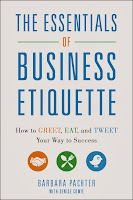Consider these recent experiences:
·
--During one
of our Sunday walks, my husband commented that I was interrupting him. I
apologized. Yet a few minutes later, he interrupted me. I
asked, with a smile on my face, “How come I am not allowed to interrupt you,
but you can interrupt me?” His response: “Is there a right answer to that
question?”
--A woman in one of my seminars told me about a delivery man who routinely walked into the office where she worked and greeted the women with "Hi, Hot Mommas.” One of her coworkers told him: “Please don't call me ‘Hot Momma,’ regardless of whether I am or not." The next day, the man again visited the office and said, "Hi, Hot Mommas" – and then pointed to the woman who had confronted him and added “...except for you.”
My
presentations include many stories, and the examples above will find their way
into some of my future seminars. Good stories reinforce and/or prove your key
points. They create a picture for your audience, bringing to life the
information you want to convey and making it much more memorable than a
recitation of statistics or data.
Following
the steps below will help you to add stories to your presentations:
1. View your experiences as opportunities to find stories. Very few of my seminar participants forget my story of going to the bathroom with my mic on. I use it to illustrate the point that it’s not what happens to you that matters, it is how you handle what happens to you. Every story doesn’t have to be as extreme as my mic incident. You will soon build a reservoir of potential stories if:
- You observe something that
illustrates a point in your presentation.
- Someone says, “That happened to
me…” in response to some point you are making. That person’s anecdote can
add another voice to your information.
- You reference someone in an article or book, or on a website, who proves your point.
2. Keep a story
file. Write
down or copy just enough detail of the story material so you will remember what
happened. Keep this information in an electronic file or in an old-fashioned
manila folder so the story will be readily available.
4. Practice. In business presentations, shorter stories generally work best. Once you have chosen a story you want to use, practice saying it out loud, using as few words as necessary to convey your point.
 The
more you include stories in your presentations, the more comfortable you become
using them. Additional information on presentation skills can be found in my
new book, The Essentials of Business Etiquette: How to Greet, Eat, and Tweet Your Way to Success. Happy Tales!
The
more you include stories in your presentations, the more comfortable you become
using them. Additional information on presentation skills can be found in my
new book, The Essentials of Business Etiquette: How to Greet, Eat, and Tweet Your Way to Success. Happy Tales! Pachter & Associates provides seminars and coaching on presentation skills and business etiquette. Contact Joyce Hoff at 856.751.6141 or Joyce@pachter.com for more information.

Great suggestions here, Barbara. Whenever I'm giving a presentation I'm always a bit apprehensive about whether or not the material will actually be impactful. I'm sure using your story suggestion will help things stick!
ReplyDeleteThis comment has been removed by a blog administrator.
ReplyDeleteThis comment has been removed by a blog administrator.
ReplyDeleteThose are even the very good stories which have been initiated here and hopefully for the future the concerning objects would amount to better understanding of the values.
ReplyDeleteUFC 205
ReplyDeleteUFC 205 Live
UFC 205 Live Stream
UFC 205 Fight Card
Watch UFC 205
Watch UFC 205 Fight Card
UFC 205 Live
UFC 205 Fight Card
UFC 205
michael kors outlet canada
ReplyDeletefitflops sale
ralph lauren
coach outlet online
louis vuitton outlet online
polo ralph lauren outlet online
polo ralph lauren outlet online
gucci outlet online
ralph lauren outlet
polo ralph lauren outlet
170601yueqin